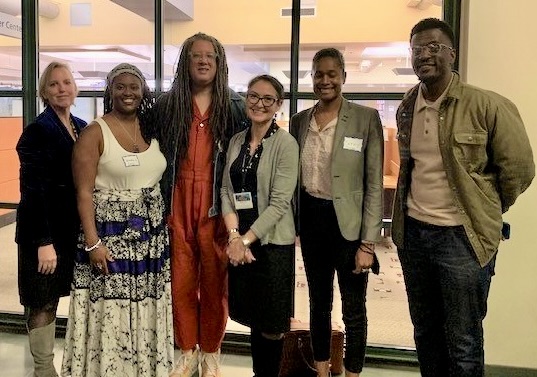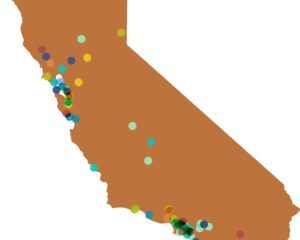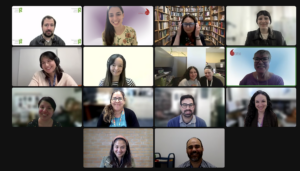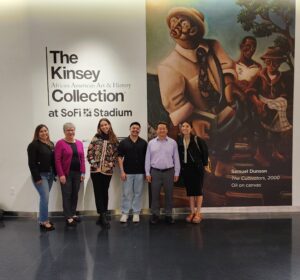Above image: Julie Fry (left), California Humanities President & CEO, and Shelly C. Lowe (center), Chair of National Endowment for the Humanities join “From Avant-Garde to Afrofuturism” panelists.
Pictured from left to right: Julie Fry, Jalondra Davis, Gary Dauphin, Chair Lowe, Cathy Thomas, and Robeson Taj Frazier. Photo courtesy of Julie Fry.
California Humanities proudly hosted this year’s National Humanities Conference in Los Angeles on November 10-13, 2022. As the host council, our staff shares some highlights on their experiences of planning a national conference, learning with and from colleagues across the nation, and connecting through shared experiences.
Brett Connor, Database & Grants Manager
Having a much more operations-focused role within a state council, I suspect that my experience at the NHC may be a little different than most others. The most impactful benefit to me was to meet colleagues, specifically other grants managers, and discuss similarities and differences in policy and procedure, as well as struggles and successes surrounding them. Those conversations seem to evolve easily, either within a conference session, or at a nearby restaurant! More on the humanities side of things, it was wonderful to hear storytelling by our past board member Natalia Molina, who was able to seamlessly weave together family, place, culture, immigration, LGBTQ issues, and food!
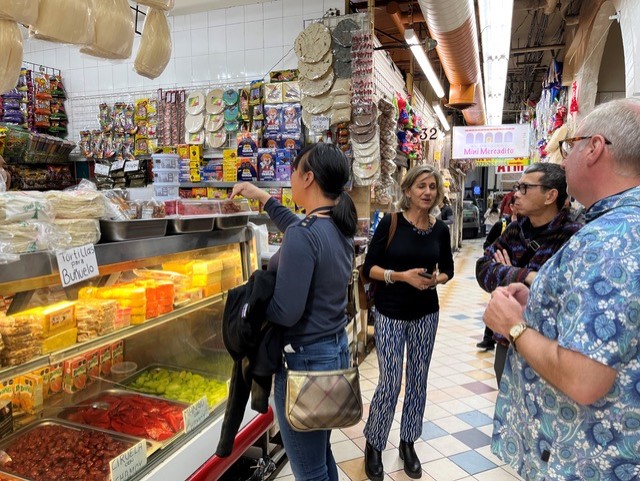
Felicia Kelley, Project & Evaluation Director
Like every previous one I’ve attended (I’m now up to 10!), this year’s annual conference offered a treasure trove of learning experiences, opportunities to hear from great thinkers (and doers), delightful chance and planned meetings with old friends and acquaintances, and renewed inspiration.
It also provided an opportunity for our guests to get a sense of LA’s incredible cultural richness, diversity, and complexity of the Los Angele firsthand. Working with our trusted community partners, we devised a series of off-site experiences, including a food tour of some of the iconic Eastside Boyle Height’s neighborhood’s most beloved culinary landmarks. For three hours on Sunday morning, culinary historian Dr. Sarah Portnoy of USC expertly guided a group of 25 as we enjoyed a movable feast of delicacies, starting with a traditional breakfast of pandulce and Mexican chocolate, then moving on to more substantial items like tacos, mole poblano, and assorted aguas frescas. Short presentations by a successful bakery owner, the innovative chef behind a growing chain of taco shops, a grandmother who helped spearhead LA’s groundbreaking campaign to legalize street vending, and the proprietor of one of the city’s “destination” taco trucks gave our visitors a chance to engage with some of the people who have made LA’s Mexican food community and culture world-famous. Along the way, we managed to squeeze in visits to historic sites like Mariachi Plaza, the Mercadito (a vibrant recreation of a traditional Mexican public market), La Casa de Puebla (a community center for immigrants from this region of Mexico), and the historic Breed Street synagogue that once anchored a thriving Jewish community in the neighborhood, now being restored as a cultural center. We hope the experience provided our guests from every part of the country plenty of food for thought as well as an enjoyable “dessert” to cap off this wonderful gathering.
Sheri Kuehl, Director of Development
With California Humanities serving as the host council of this year’s National Humanities Conference in Los Angeles, it was an honor to welcome conference attendees to Los Angeles and a pleasure to hear our guests respond to so many special sessions highlighting LA.
With such a focus on our home state, it is curious that one of my most memorable moments of the conference was during a session that transported me to rural Georgia.
Those of us in attendance initially learned two things about Putnam County, Georgia. It has one of the highest levels of persistent intergenerational poverty of all counties across the United States, and it is an important site for exploring how public humanities and public education can impact one another.
Presenters shared their efforts to get students out from behind desks and into their community through an innovative, place-based curriculum designed to weave together history, literature, and the visual and performing arts.
Following an overview from the educators, most of the session was conducted by six high school students who described where this work has taken them. From in-depth oral history projects to original compositions connecting their lives to the complicated history of their community, the students – some sharing their research and some offering short performances – were clearly proud of their work and eager to share the stories of their community.
As the student’s presentations closed, session attendees were visibly moved and clearly inspired not only by the students’ presentations but also by the commitment and passion the educators brought to the project.
When high school drama teacher Anna Brock casually mentioned that a production of A Midsummer Night’s Dream, designed through a Putnam County lens, was in the works, the person seated on my left – a stranger – turned to me and said, “we should go!” Indeed.

John Lightfoot, Director of Media and Journalism Programs
There were several highlights for me at the recent National Humanities Conference in Los Angeles, first of which was seeing colleagues from around the country in person for the first time since the last NHC gathering in 2019. It was reassuring to see so many other councils thriving and continuing to do such meaningful work in their states and communities. Programming highlights included a presentation by filmmakers Shaleece Haas and Hunter Pixel Jimenez about their co-directed short film commissioned by California Humanities, To the Future, With Love, and a talk by USC Professor and former-California Humanities board member Natalia Molina about the community that grew around the Boyle Heights Mexican restaurant founded her grandmother in the 1950s. Most mind-expanding however was the closing plenary, From Avant-Garde to Afrofuturism, where panelists grappled with the past, present, and future of Afrofuturism in everything from literature, film, music, digital culture, fantasy and more.
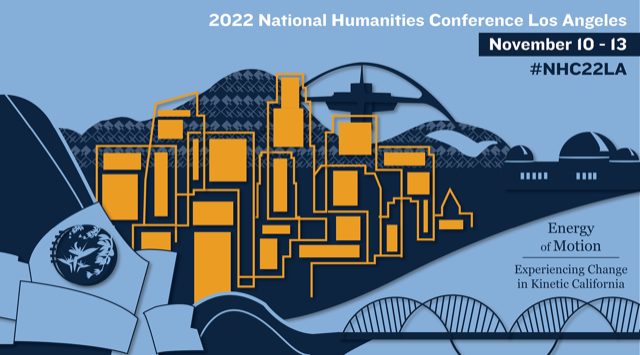
Steven Loscutoff, Administration Associate
During my time at the National Humanities Conference, I thought about the coming together of so many humanities council administrators, practitioners, and academics from across the nation, bringing with them a wide range of thoughts and experiences. This made me think broadly about people gathering in space and our relationship to location and our perceptions of it. With this in mind, the Atascosa Borderlands presentation and discussion was one example of humanities-based projects that furthered my reflection on such concepts. This project examined the changing nature of the Atascosa Highlands through the documentation of migratory routes (both natural and man-made), ecological reviews, and archival oral histories from a plethora of local inhabitants in order to provide a nuanced view of the complex and ever-changing relationship between people, time, and space. While at first glance the mountainous Atascosa region may resembles a place that is inaccessible, forgotten, or devoid of meaning, I could see the poetic similarities with the humanities in general through its’ own capability to present the interconnectedness, constant flux, and untold stories that make up our histories, cultures, and societies. In the end, these things are not far out of our reach, so long as we take the opportunity to expand our viewpoints and be present in that given moment when something new and fantastic may be revealed.
Side note: Steven designed the NHC2022 graphic. You can read about the iconic Los Angeles images in his design here.
Beth Segura, Operations Coordinator
My very first National Humanities Conference was tremendously meaningful for a variety of reasons: it was a special celebration of my home state, it was brimming with powerful humanities conversations, and it was my first time gathering with several of my colleagues in person. There is also nothing quite like being in a community of humanities experts and practitioners from every state in the nation who share a common set of values and who deeply know the importance of this work. I’ve watched my colleagues at California Humanities work tirelessly for the past year to make this conference possible, in collaboration with the Federation of State Humanities Councils and the National Humanities Alliance, and it was a joy to see its enormous success this past week.
One common theme that I have carried with me, which I encountered in several sessions and tours, was the conversation around how we engage in storytelling. A particular question that came to the front of mind was this: how do we tell stories about humans who have experienced erasure in history, in the world, in their lives? During the tour of the special Black Cinema exhibit at the Academy Museum of Motion Pictures, I was struck by the stories of persistence, resilience, activism, and art amid a historically racist industry. Similarly, the sessions of Embodied Narrative/ Storied Movement, Questions as Bridges, Black Utopianism, California Snapshots, and Making Space for Community Stories, along with the three large evening presentations, brought these same thoughts to my mind. I always appreciated that there were no black and white answers, but plenty of invitations to listen and discuss, propelling the state councils forward in their programming. The closing plenary on Afrofuturism was a beautiful way to wrap up the conference, revealing how a community has used whimsy, play, and imagination to understand their humanity and to dream about their future. I felt so honored to be part of the host state council during this conference, and I am grateful to have walked away with such inspiration along with an expanded sense of hope.

Christi Shortridge, Interim Communications Director
The National Humanities Conference for me was a time of connection…connection with colleagues who I had not seen for years and with new colleagues who I had only met in a Zoom square. Connection through story circles. Reconnections over a dinner of Peruvian tapas, salads in a French bistro, and a satisfying meal of Taiwanese comfort food and chrysanthemum tea. Connection through stories on a stroll through the multitude of gorgeous gardens at the Huntington Library, Art Museum, and Botanical Gardens. Connecting over films while on a gleeful Angels Flight ride, gazing skyward
at Art Deco features on buildings, and sharing favorite scenes from the original Blade Runner as we stepped inside a hushed Bradbury Building that was part of the Historic Downtown Los Angeles Walking Tour. Even connecting with and learning from colleagues across the country at my own session about engaging audiences and connecting with community. The National Humanities Conference for me highlighted connecting with people who I have missed seeing during the pandemic and making new connections during my time in Los Angeles.
Lucena Lau Valle, Program Officer
Taking part in “A Landscape in Motion: A Walking Tour of the Los Angeles River,” was one the highlights of my time at the 2022 National Humanities Conference. Our guide Anthea Raymond, of L.A. River Corgis, provided an interactive walking tour of a stretch of the Los Angeles River, north of Downtown Los Angeles. Anthea’s tour thoughtfully wove together the history of the river’s paving and channelization by the US Army Corps of Engineers in the 1930s, with stories of the river’s rediscovery by poets and environmental activists in the 1980s, to contemporary
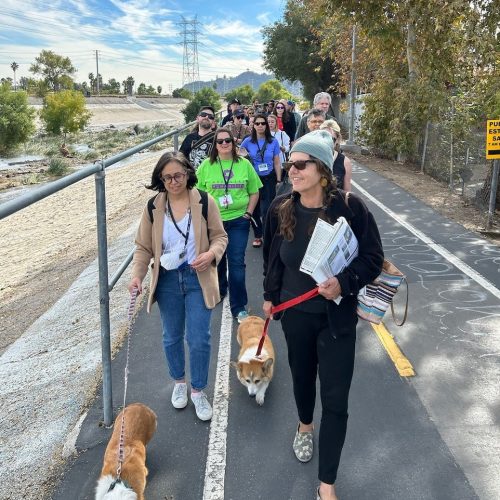
efforts to restore the Los Angeles River’s riparian ecosystems. We were also joined by Anthea’s friendly corgis’ Kasha and Chase who were welcomed companions on our tour. After taking part in Anthea’s tour, I am inspired by the ways that the eco humanities provide a powerful bridge between the sciences and the humanities.
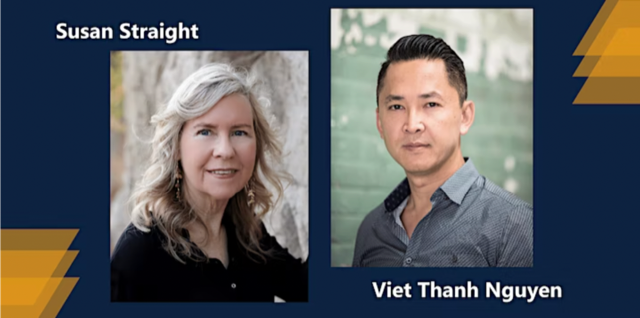
Kirsten Vega, Associate Program Officer
My highlight of the National Humanities Conference was an evening talk with writers Susan Straight and Viet Thanh Nguyen. Despite being set in a crowded theater in downtown LA, their friendship infused the conversation with easy warmth, making a listener feel like a fly on the wall as Susan and Viet Thanh told their “writer origin stories.” While they grew up with native tongues and in different zip codes, both credit their childhood libraries as spaces where they escaped to think and read; a reminder that writers are readers first and librarians matter. Susan shared a piece of advice given to her by James Baldwin, that writers don’t need to live in New York City to lead story-worthy lives, but rather it is “imperative” for writers to linger in their hometowns, in Straight’s case Riverside, California, and write the stories of America’s unique small places. This struck me as a powerful affirmation of the stories of California’s rural communities.
Side note: After the talk, I met a friend next door for a life-changingly good matcha soft serve. If you find yourself in Little Tokyo downtown Los Angeles, I highly recommend a visit to Tea Master Matcha Café!
Julie Fry, President & CEO
California Humanities was proud to host this year’s National Humanities Conference in Los Angeles. We had the pleasure of hosting the conference one other time, in San Francisco in 2005. That one was a nail-biter, according to Esther Mackintosh, then the President & CEO of the Federation of State Humanities Council: there had been a hotel strike locally in the months preceding the conference, and we didn’t know whether the conference hotel would be available. I can’t tell you how relieved we all were that in 2022 we were able to experience a jubilant coming together of the public humanities community after several years apart, with the largest number of registrants ever for this annual conference. We’d like to thank the conference producers for their amazing attention to detail; this gathering wouldn’t have happened without the efforts of the staff at the Federation of State Humanities Councils and the National Humanities Alliance. I’d also like to thank everyone on the California Humanities staff; everyone had a role to play in helping to bring the conference to life. Particular thanks go to Felicia Kelley and Lucena Lau Valle, our LA-based staff, for all of their local knowledge, ideas, and connections.
The highlights for me were plentiful, from seeing familiar faces to meeting first-time attendees, from the opening night welcoming remarks of California State Senator Ben Allen – himself a humanist – to the plenary speakers who reflected California’s origin stories while illuminating the people who call this place home. I was struck, walking through the conference hotel at any given time, by the Energy of Motion all around us. In one direction I could hear sessions and presentations underway, in another there were people from the far parts of the country in animated conversation, and in yet another, groups climbed on buses to travel to a local humanities jewel. How fun was it to be out on a rooftop terrace, surround by LA’s skyscrapers while listening to the Mariachi Divas play in the cool night air? The conference was made up of hundreds of particles like this: moving, profound, and compelling ideas and experiences. This is the kinetic California we know and love. (If you haven’t seen it yet, dive into our conference video, a little love letter to Los Angeles, you can view it here.)

